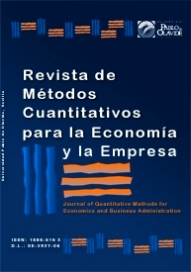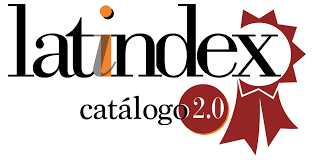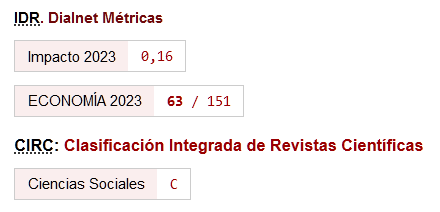Emprendimiento y crecimiento económico: nueva evidencia de Irán
DOI:
https://doi.org/10.46661/rev.metodoscuant.econ.empresa.8424Palabras clave:
emprendimiento, crecimiento económico, Rezagos Distribuidos Autorregresivos (ARDL)Resumen
El emprendimiento es un recurso vital e inagotable en todos los países, desempeñando un papel crucial en su desarrollo. Es un recurso valioso y rentable que gira en torno a la creatividad humana y la capacidad de innovar. Las sociedades que se basan en el capital humano y la capacidad intelectual en lugar de depender únicamente de los recursos naturales tienden a lograr un mayor éxito a largo plazo. Este estudio examina el impacto del emprendimiento en el crecimiento económico en Irán dentro del marco de un modelo de crecimiento. Se emplea el método de Rezagos Distribuidos Autorregresivos (ARDL) para analizar datos que abarcan desde 1980 hasta 2022. Los hallazgos revelan que varios índices de emprendimiento tienen un efecto positivo y significativo en el crecimiento económico de Irán durante el período de tiempo especificado. Los resultados del estudio indican la necesidad de implementar estrategias más avanzadas para acelerar la tasa de crecimiento y avanzar más rápidamente hacia el marco schumpeteriano. Los responsables de las políticas deben poner mayor énfasis en fomentar iniciativas emprendedoras innovadoras para lograr un crecimiento y desarrollo económico mejorados.
Descargas
Citas
Adam Smith. (1776). An Inquiry into the Nature and Causes of the Wealth of Nations.
https://doi.org/10.1093/oseo/instance.00043218 DOI: https://doi.org/10.1093/oseo/instance.00043218
Aghaei, M., Rezagholizadeh, M., Abdi Seyyedkolaee, M., & Mosavi, R. (2024). Investigation of 'The Financial Resources Curse' Hypothesis in Iraq: Application of ARDL and NARDL Models. Iranian Economic Review, (In press), -. doi: 10.22059/ier.2024.367447.1007836.
Aparicio, S., Urbano, D., & Audretsch, D. (2016). Institutional factors, opportunity entrepreneurship and economic growth: Panel Data Evidence. Technological Forecasting and Social Change, 102, 45-61.
https://doi.org/10.1016/j.techfore.2015.04.006 DOI: https://doi.org/10.1016/j.techfore.2015.04.006
Audretsch, D. B., & Thurik, A. R. (2004). A Model of the Entrepreneurial Economy. International Journal of Entrepreneurship Education, 2(2), 143-166.
Baumol, W. J. (1993). Entrepreneurship, management, and the structure of payoffs. Cambridge Journal of Economics, 17(1), 63-73.
Bosma, N., Sanders, M., & Stam, E. (2018). Institutions, entrepreneurship, and economic growth in Europe. Small Business Economics, 51(2), 483-499.
https://doi.org/10.1007/s11187-018-0012-x DOI: https://doi.org/10.1007/s11187-018-0012-x
Capelleras, J. L., Contin-Pilart, I., Larraza-Kintana, M., & Martin-Sanchez, V. (2019). Entrepreneurs' human capital and growth aspirations: The moderating role of regional entrepreneurial culture. Small Business Economics, 52(1), 3-25.
https://doi.org/10.1007/s11187-017-9985-0 DOI: https://doi.org/10.1007/s11187-017-9985-0
Cao, Z., & Shi, X. (2021). A systematic literature review of entrepreneurial ecosystems in advanced and emerging economies. Small Business Economics, 57(1), 75-110.
https://doi.org/10.1007/s11187-020-00326-y DOI: https://doi.org/10.1007/s11187-020-00326-y
Dewi, S., Majid, M. S. A., Aliasuddin, A., & Kassim, S. H. (2018). Dynamics of financial development, economic growth and poverty alleviation: The Indonesian experience. The South East European Journal of Economics and Business, 13(1), 17-30.
https://doi.org/10.2478/jeb-2018-0002 DOI: https://doi.org/10.2478/jeb-2018-0002
Engle, R. F., & Granger, C. W. (1987). Co-integration and error correction: Representation, estimation, and testing. Econometrica: Journal of the Econometric Society, 55(2), 251-276.
https://doi.org/10.2307/1913236 DOI: https://doi.org/10.2307/1913236
Gaba, A. K., & Gaba, N. (2022). Entrepreneurial activity and economic growth of BRICS countries: Retrospect and prospects. Journal of Entrepreneurship, 31(2), 402-424.
https://doi.org/10.1177/09713557221097160 DOI: https://doi.org/10.1177/09713557221097160
Galindo-Martín, M. Á., Castaño-Martínez, M. S., & Méndez-Picazo, M. T. (2021). The role of entrepreneurship in different economic phases. Journal of Business Research, 122, 171-179.
https://doi.org/10.1016/j.jbusres.2020.08.050 DOI: https://doi.org/10.1016/j.jbusres.2020.08.050
Galindo, M.A. & Méndez, M.T, (2014). Entrepreneurship, economic growth, and innovation: Are feedback effects at work? Journal of Business Research, 67(5), 825-829.
https://doi.org/10.1016/j.jbusres.2013.11.052 DOI: https://doi.org/10.1016/j.jbusres.2013.11.052
Gautam, S., & Lal, M. (2021). Entrepreneurship and economic growth: Evidence from G-20 economies. Journal of East-West Business, 27(2), 140-159.
https://doi.org/10.1080/10669868.2020.1859427 DOI: https://doi.org/10.1080/10669868.2020.1859427
González-Sánchez, V., Antonio Martínez, R., & de los Ríos-Sastre, S. (2020). An empirical study for European countries: Factors affecting economic growth and self-employment by gender. Sustainability (Switzerland), 12(22), 1-15.
https://doi.org/10.3390/su12229450 DOI: https://doi.org/10.3390/su12229450
Gould, J. P. (1972). The origins of status hierarchies: A formal theory and empirical test. American Journal of Sociology, 78(4), 1078-1108.
Gu, W., & Wang, J. (2022). Research on index construction of sustainable entrepreneurship and its impact on economic growth. Journal of Business Research, 142, 266-276.
https://doi.org/10.1016/j.jbusres.2021.12.060 DOI: https://doi.org/10.1016/j.jbusres.2021.12.060
Hayek, F. A. (1945). The Use of Knowledge in Society. The American Economic Review, 35(4), 519-530.
Holcombe, R. G. (1998). Entrepreneurship and Economic Growth. The Quarterly Journal of Austrian Economics, 1(2), 45-62.
https://doi.org/10.1007/s12113-998-1008-1 DOI: https://doi.org/10.1007/s12113-998-1008-1
Johnson, B. R. (1990). Toward a multi-dimensional model of entrepreneurship: The case of achievement motivation and the entrepreneur. Entrepreneurship Theory and Practice, 14(3), 39-54.
https://doi.org/10.1177/104225879001400306 DOI: https://doi.org/10.1177/104225879001400306
Kremers, J. J., Ericsson, N. R., & Dolado, J. J. (1992). The power of cointegration tests. Oxford Bulletin of Economics and Statistics, 54(3), 325-347.
https://doi.org/10.1111/j.1468-0084.1992.tb00005.x DOI: https://doi.org/10.1111/j.1468-0084.1992.tb00005.x
Kirzner, I. M. (1973). Competition and Entrepreneurship. The University of Chicago Press.
Lucas, R. (1988). On the mechanics of economic development. Journal of Monetary Economics, 22, 3-42.
https://doi.org/10.1016/0304-3932(88)90168-7 DOI: https://doi.org/10.1016/0304-3932(88)90168-7
Narayan, P. K. (2005). The saving and investment nexus for China: Evidence from cointegration tests. Applied Economics, 37(17), 1979-1990. https://doi.org/10.1080/00036840500278103. DOI: https://doi.org/10.1080/00036840500278103
Neves, P. C., Afonso, Ó., & Silva, S. T. (2016). A meta-analytic reassessment of the effects of inequality on growth. World Development, 78, 386-400.
https://doi.org/10.1016/j.worlddev.2015.10.038 DOI: https://doi.org/10.1016/j.worlddev.2015.10.038
Pesaran, M. H., Shin, Y., & Smith, R. J. (2001). Bounds testing approaches to the analysis of level relationships. Journal of Applied Economics, 16(3), 289-326.
https://doi.org/10.1002/jae.616 DOI: https://doi.org/10.1002/jae.616
Pesaran, M. H. (2007). A simple panel unit root test in the presence of cross‐section dependence. Journal of Applied Econometrics, 22(2), 265-312.
https://doi.org/10.1002/jae.951 DOI: https://doi.org/10.1002/jae.951
Prasetyo, P. E., & Kistanti, N. R. (2020). Human capital, institutional economics and entrepreneurship as a driver for quality and sustainable economic growth. Entrepreneurship and Sustainability Issues, 7(4), 2575.
https://doi.org/10.9770/jesi.2020.7.4(1) DOI: https://doi.org/10.9770/jesi.2020.7.4(1)
Pradhan, R., Rvin, M., Nair, M., & Bennett, S. (2020). The dynamics among entrepreneurship, innovation, and economic growth in the Eurozone countries. Journal of Policy Modeling, 42(5), 1106-1122.
https://doi.org/10.1016/j.jpolmod.2020.01.004 DOI: https://doi.org/10.1016/j.jpolmod.2020.01.004
Prieger, J. E., Bampoky, C., Blanco, L. R., & Liu, A. (2016). Economic growth and the optimal level of entrepreneurship. World Development, 82, 95-109.
https://doi.org/10.1016/j.worlddev.2016.01.013 DOI: https://doi.org/10.1016/j.worlddev.2016.01.013
Ramsey, F. P. (1928). A mathematical theory of saving. Economic Journal, 38(152), 543-559.
https://doi.org/10.2307/2224098 DOI: https://doi.org/10.2307/2224098
Romer, P. M. (1990). Endogenous technological change. Journal of Political Economy, 98(5, Part 2), S71-S102.
https://doi.org/10.1086/261725 DOI: https://doi.org/10.1086/261725
Salazar, M. (2004). An introduction on entrepreneurship. Translated by Siamat Notagh. 1st edition. National Productivity Organization of Iran.
Schmitz, J. A. (1989). Imitation, entrepreneurship, and long-run growth. Journal of Political Economy, 97(3), 721-739.
https://doi.org/10.1086/261624 DOI: https://doi.org/10.1086/261624
Schumpeter, J. A. (1911). The Theory of Economic Development: An Inquiry into Profits, Capital, Credit, Interest, and the Business Cycle. Harvard University Press.
Shan, S., Locke, E., & Collin, C. (2003). Entrepreneurial motivation. Human Resource Management Review, 13, 257-279.
https://doi.org/10.1016/S1053-4822(03)00017-2 DOI: https://doi.org/10.1016/S1053-4822(03)00017-2
Stam, E., & Van de Ven, A. (2021). Entrepreneurial ecosystem elements. Small Business Economics, 56(2), 809-832.
https://doi.org/10.1007/s11187-019-00270-6 DOI: https://doi.org/10.1007/s11187-019-00270-6
Solow, R. M. (1956). A contribution to the theory of economic growth. The Quarterly Journal of Economics, 70(1), 65-94.
https://doi.org/10.2307/1884513 DOI: https://doi.org/10.2307/1884513
Szerb, L., Lafuente, E., Horváth, K., & Páger, B. (2019). The relevance of quantity and quality entrepreneurship for regional performance: The moderating role of the entrepreneurial ecosystem. Regional Studies, 53(9), 1308-1320.
https://doi.org/10.1080/00343404.2018.1510481 DOI: https://doi.org/10.1080/00343404.2018.1510481
Urbano, D., & Aparicio, S. (2016). Entrepreneurship capital types and economic growth: International evidence. Technological Forecasting and Social Change, 102, 34-44.
https://doi.org/10.1016/j.techfore.2015.02.018 DOI: https://doi.org/10.1016/j.techfore.2015.02.018
Tahir, M., & Burki, U. (2023). Entrepreneurship and economic growth: Evidence from the emerging BRICS economies. Journal of Entrepreneurship and Public Policy, 12(3), 345-367. https://doi.org/10.1108/JEPP-04-2022-0031.
Urbano, D., Aparicio, S., & Audretsch, D. (2019). Twenty-five years of research on institutions, entrepreneurship, and economic growth: What has been learned? Small Business Economics, 53(1), 21-49.
https://doi.org/10.1007/s11187-018-0038-0 DOI: https://doi.org/10.1007/s11187-018-0038-0
Urbano, D., Audretsch, D., Aparicio, S., & Noguera, M. (2020). Does entrepreneurial activity matter for economic growth in developing countries? The role of the institutional environment. International Entrepreneurship and Management Journal, 16(3), 1065-1099.
https://doi.org/10.1007/s11365-019-00621-5 DOI: https://doi.org/10.1007/s11365-019-00621-5
Wennekers, S., van Stel, A., Thurik, R., & Reynolds, P. (2005). Nascent entrepreneurship and the level of economic development. Small Business Economics, 24(3), 293-309.
https://doi.org/10.1007/s11187-005-1994-8 DOI: https://doi.org/10.1007/s11187-005-1994-8
Descargas
Publicado
Cómo citar
Número
Sección
Licencia
Derechos de autor 2024 majid aghaei

Esta obra está bajo una licencia internacional Creative Commons Atribución-CompartirIgual 4.0.
El envío de un manuscrito a la Revista supone que el trabajo no ha sido publicado anteriormente (excepto en la forma de un abstract o como parte de una tesis), que no está bajo consideración para su publicación en ninguna otra revista o editorial y que, en caso de aceptación, los autores están conforme con la transferencia automática del copyright a la Revista para su publicación y difusión. Los autores retendrán los derechos de autor para usar y compartir su artículo con un uso personal, institucional o con fines docentes; igualmente retiene los derechos de patente, de marca registrada (en caso de que sean aplicables) o derechos morales de autor (incluyendo los datos de investigación).
Los artículos publicados en la Revista están sujetos a la licencia Creative Commons CC-BY-SA de tipo Reconocimiento-CompartirIgual. Se permite el uso comercial de la obra, reconociendo su autoría, y de las posibles obras derivadas, la distribución de las cuales se debe hacer con una licencia igual a la que regula la obra original.
Hasta el volumen 21 se ha estado empleando la versión de licencia CC-BY-SA 3.0 ES y se ha comenzado a usar la versión CC-BY-SA 4.0 desde el volumen 22.










